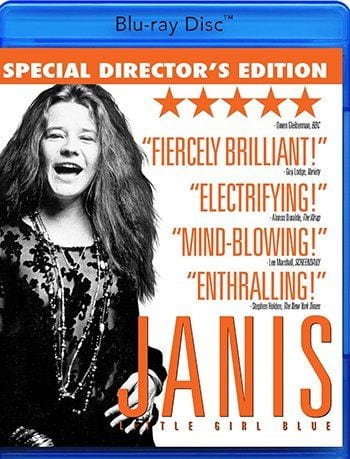
This isn’t a film about a rock musician who lived fast, died young and left a good looking corpse. Instead, it’s the story of a woman whose main ambition in life was to live well, become recognized for her talents and find love. She got one of those. Little Girl Blue first emerged as part of PBS’ American Masters series and has since become a favorite on streaming services. Little wonder. It has all the makings of a dramatic box office hit that, in its final moments, packs an emotional punch that even the most hardened of hearts can’t help but be moved by.
Featuring interviews with close friends, including members of Big Brother and Holding Company, talk show host Dick Cavett, the Grateful Dead’s Bob Weir, plus her siblings, former lovers and the like, the documentary follows Joplin from her life in small town Texas to stardom to a lonesome death at the age of 27. As documented elsewhere, the singer was no shrinking violet and so the stories of her ability to start fights with complete strangers or hold her own against egotistical counterparts comes as no surprise. Drink exacerbated her outspoken ways, drugs and life on the road further isolated her from the peers who didn’t always know quite to make of her.
She was not a traditionally good looking woman, though her intellect and talent lent and added sex appeal. But the early wounds, including being voted Ugliest Man on Campus in college didn’t help. The small minds and small world that allowed that to happen couldn’t hold her long. She soon broke free, made her way to San Francisco, experimented with drugs and sex and soon found that it was all more than she could handle.
A second go at music proved more fruitful and by the middle of the ’60s she was on her way to stardom. Her performance at the Monterey Pop Festival forever changed how she and the music she performed was perceived. Big Brother and Holding Company turned ears and heads and was over faster than it should have been.
Joplin’s need for chemical relief became heightened when she was on her own. Whatever stability she’d created working in a steady band fell away. She struggled with heroin, got clean and began to make the most meaningful music of her short life. What she couldn’t find was love, either within or from another. She came close and the man who could have given her what no one else could had sadly arrived too late. Here, he delivers an emotional blow so moving that making your way to the end of the film dry-eyed becomes impossible.
Little Girl Blue succeeds in part because it avoids rock doc clichés. The endless testimonials from fellow musicians about the magnitude of Joplin’s talents and powers come only in the credits. By then we’re convinced that she was a talent like no other. Hearing her final recordings juxtaposed with stories about her final days is a powerful experience and maybe the very thing that makes the whole film worthwhile.
There’s plenty of archival footage from Joplin’s appearances on talk shows and from the stage. There’s also revealing clips of Big Brother in the studio, working on their unparalleled brand of rock, blues and soul. We see her on the Festival Express with Jerry Garcia and friends. We hear some of the mid-song raps that added dimension to the songs she wrote that were tearing up the charts. A surprising amount of correspondence has survived and images and readings of these letters illuminates the anecdotes that friends and family deliver.
Most remarkable in all of this is Joplin’s own intelligence and her ability to overcome the external obstacles that stood in her way, the bullies and naysayers in particular. She existed in the rock world at a time when, really, no other woman did, or certainly not at her level. That’s a point that gets made but not overemphasized in this context. She did it all before the age of 27, and she lived a lifetime in the space of half a decade doesn’t inspire as much sadness as it does admiration. (Though, certainly, her struggles with addiction do evoke sympathy.)
The DVD release features a variety of deleted and extended scenes, talk of Joplin’s influence and footage from her Walk of Fame ceremony. Do they add much? Probably not. But then again, what really could improve upon a work this good?


![Call for Papers: All Things Reconsidered [MUSIC] May-August 2024](https://www.popmatters.com/wp-content/uploads/2024/04/all-things-reconsidered-call-music-may-2024-720x380.jpg)



